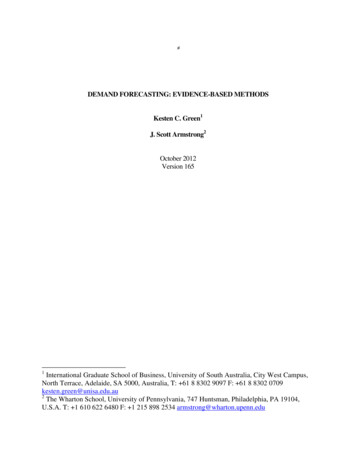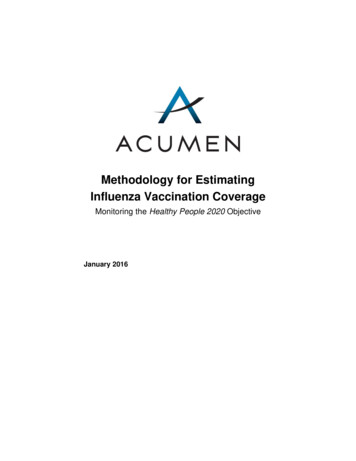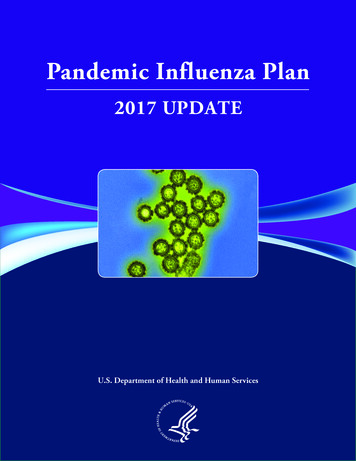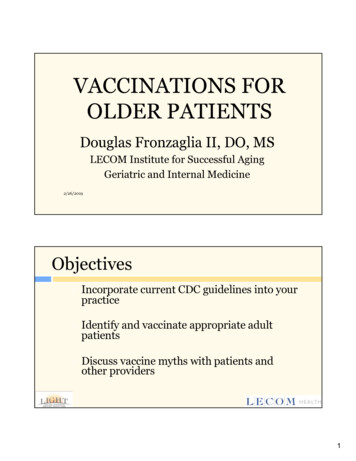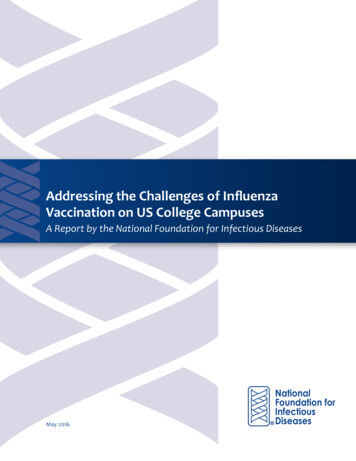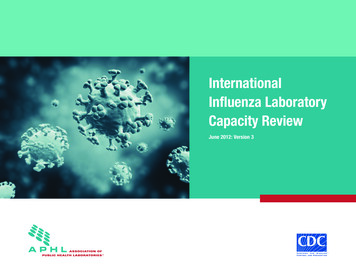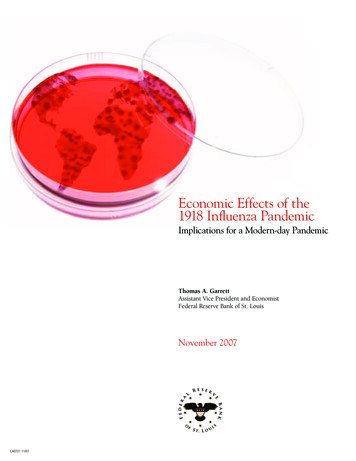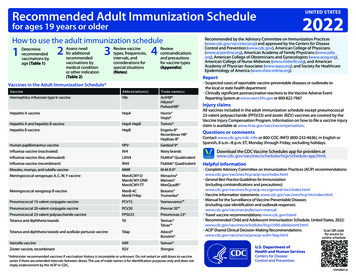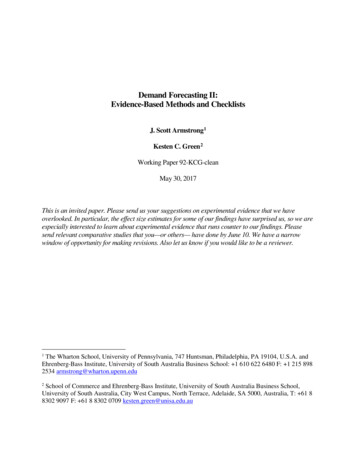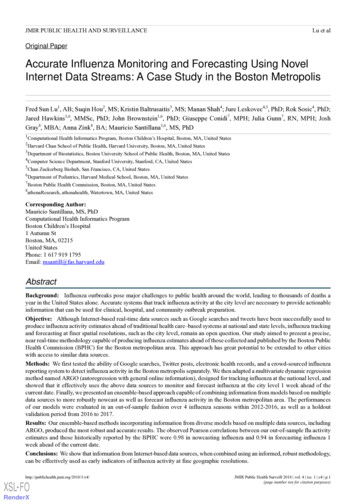
Transcription
JMIR PUBLIC HEALTH AND SURVEILLANCELu et alOriginal PaperAccurate Influenza Monitoring and Forecasting Using NovelInternet Data Streams: A Case Study in the Boston MetropolisFred Sun Lu1, AB; Suqin Hou2, MS; Kristin Baltrusaitis3, MS; Manan Shah4; Jure Leskovec4,5, PhD; Rok Sosic4, PhD;Jared Hawkins1,6, MMSc, PhD; John Brownstein1,6, PhD; Giuseppe Conidi7, MPH; Julia Gunn7, RN, MPH; JoshGray8, MBA; Anna Zink8, BA; Mauricio Santillana1,6, MS, PhD1Computational Health Informatics Program, Boston Children’s Hospital, Boston, MA, United States2Harvard Chan School of Public Health, Harvard University, Boston, MA, United States3Department of Biostatistics, Boston University School of Public Health, Boston, MA, United States4Computer Science Department, Stanford University, Stanford, CA, United States5Chan Zuckerberg Biohub, San Francisco, CA, United States6Department of Pediatrics, Harvard Medical School, Boston, MA, United States7Boston Public Health Commission, Boston, MA, United States8athenaResearch, athenahealth, Watertown, MA, United StatesCorresponding Author:Mauricio Santillana, MS, PhDComputational Health Informatics ProgramBoston Children’s Hospital1 Autumn StBoston, MA, 02215United StatesPhone: 1 617 919 1795Email: msantill@fas.harvard.eduAbstractBackground: Influenza outbreaks pose major challenges to public health around the world, leading to thousands of deaths ayear in the United States alone. Accurate systems that track influenza activity at the city level are necessary to provide actionableinformation that can be used for clinical, hospital, and community outbreak preparation.Objective: Although Internet-based real-time data sources such as Google searches and tweets have been successfully used toproduce influenza activity estimates ahead of traditional health care–based systems at national and state levels, influenza trackingand forecasting at finer spatial resolutions, such as the city level, remain an open question. Our study aimed to present a precise,near real-time methodology capable of producing influenza estimates ahead of those collected and published by the Boston PublicHealth Commission (BPHC) for the Boston metropolitan area. This approach has great potential to be extended to other citieswith access to similar data sources.Methods: We first tested the ability of Google searches, Twitter posts, electronic health records, and a crowd-sourced influenzareporting system to detect influenza activity in the Boston metropolis separately. We then adapted a multivariate dynamic regressionmethod named ARGO (autoregression with general online information), designed for tracking influenza at the national level, andshowed that it effectively uses the above data sources to monitor and forecast influenza at the city level 1 week ahead of thecurrent date. Finally, we presented an ensemble-based approach capable of combining information from models based on multipledata sources to more robustly nowcast as well as forecast influenza activity in the Boston metropolitan area. The performancesof our models were evaluated in an out-of-sample fashion over 4 influenza seasons within 2012-2016, as well as a holdoutvalidation period from 2016 to 2017.Results: Our ensemble-based methods incorporating information from diverse models based on multiple data sources, includingARGO, produced the most robust and accurate results. The observed Pearson correlations between our out-of-sample flu activityestimates and those historically reported by the BPHC were 0.98 in nowcasting influenza and 0.94 in forecasting influenza 1week ahead of the current date.Conclusions: We show that information from Internet-based data sources, when combined using an informed, robust methodology,can be effectively used as early indicators of influenza activity at fine geographic /XSL FORenderXJMIR Public Health Surveill 2018 vol. 4 iss. 1 e4 p.1(page number not for citation purposes)
JMIR PUBLIC HEALTH AND SURVEILLANCELu et al(JMIR Public Health Surveill 2018;4(1):e4) doi:10.2196/publichealth.8950KEYWORDSepidemiology; public health; machine learning; regression analysis; influenza, human; communicable diseases; statistics; patientgenerated dataIntroductionmethodological improvements have shown that Internet searchesare a viable way to monitor influenza [7,11-13].Traditional Influenza SurveillanceCloud-based electronic health records (EHRs) are another datasource that can be obtained in near real-time [14]. Participatinghealth care providers can report influenza cases as they occur,giving early approximations of the true infection rate. InSantillana et al [15], an ensemble approach combining thesedata sources outperformed any other methods in national flupredictions. In addition, traditional susceptible-infectedrecovered (SIR) epidemiological models coupled with dataassimilation techniques have shown strong potential inpredicting influenza activity in multiple spatial resolutions[16,17]. Finally, participatory disease surveillance efforts wherea collection of participants report whether they experienced ILIsymptoms on a weekly basis, such as Flu Near You (FNY) inthe United States, Influenzanet in Europe, and Flutracking inAustralia, show promise in monitoring influenza activity inpopulations not frequently surveilled by health care–basedsurveillance systems [18-21].Seasonal influenza is a major public health concern across theUnited States. Each year, over 200,000 hospitalizations fromcomplications related to influenza infection occur nationwide,resulting in 3000 to 50,000 deaths [1]. Worldwide, up to 500,000deaths occur annually due to influenza [2]. Vaccination is theprimary prevention method [3], but other prevention andmitigation strategies are also important for reducing transmissionand morbidity, including infection control procedures, earlytreatment, allocation of emergency department (ED) resources,and media alerts. Accurate and timely surveillance of influenzaincidence is important for situation awareness and responsemanagement.Governmental public health agencies traditionally collectinformation on laboratory confirmed influenza cases and reportsof visits to clinics or EDs showing symptoms of influenza-likeillness (ILI). ILI is symptomatically defined by the Centers forDisease Control and Prevention (CDC) as a fever greater than100 F and cough or sore throat [4]. The CDC publishes weeklyreports for national and multistate regional incidence, whereasstate and city data are sometimes published by local agenciessuch as the Boston Public Health Commission (BPHC). Thesesystems provide consistent historical information to track ILIlevels in the US population [5,6]. However, they often involvea 1- to 2-week lag, reflecting the time needed for informationto flow from laboratories and clinical databases to a centralizedinformation system, and tend to undergo subsequent revisions.The time lag delays knowledge of current influenza activity,thus limiting the ability for timely response management.Additionally, this time lag makes it harder to predict futureactivity.Real-Time Surveillance ModelsTo address this issue, research teams have demonstrated theability to monitor national and regional (collections of 5 stateswithin the United States defined by the Department of Healthand Human Services) influenza incidence in near real-time bycombining various disparate sources of information. Historicalflu activity shows both seasonal and short-term predictability,and models that use such autoregressive information can captureand estimate the salient features of epidemic outbreaks [7].Rapidly updating data streams have also been found to showstrong value in influenza monitoring at the national and regionallevels. As early as 2006, analysis of Internet search activity hasshown the potential to predict official influenza syndromic data[8]. In 2008, Google Flu Trends (GFT) launched one of the firstprojects to utilize Internet searches as predictors of influenzaactivity, eventually providing predictions from 2003 to 2015using search volumes around the globe [9]. Although flaws havebeen identified in Google’s original methods and results [10],http://publichealth.jmir.org/2018/1/e4/XSL FORenderXFiner Spatial ResolutionsAlthough significant progress in tracking and predictinginfluenza activity using novel data sources has been made atlarger geographical scales, detection at finer spatial resolutions,such as the city level, is less well understood [7,12,14-15,22-26].Models aiming at tracking the number of influenza-positivecase rates at the city level have been developed with moderatesuccess, including a network mechanistic model for theneighborhoods and boroughs of New York City based on thetraditional SIR methodology [27]. Models combining Twitterand Google Trends data have also been tested in the same city[28], as well as in a Baltimore hospital [29].In this paper, we demonstrate the feasibility of combiningvarious Internet-based data sources using machine learningtechniques to monitor and forecast influenza activity in theBoston metropolitan area, by extending proven methods fromthe national- and regional-level influenza surveillance literatureto the city-level resolution. We then develop ensemblemeta-predictors on these methods and show that they producethe most robust results at this geographical scale. Our methodswere used to produce out-of-sample influenza estimates from2012 to 2016 as well as out-of-sample validation on previouslyunseen official influenza activity data from the 2016-2017seasons. Our contribution shows that the lessons learned fromtracking influenza at broader geographical scales, such as thenational and regional levels in the United States, can be adaptedwith success at finer spatial resolutions.JMIR Public Health Surveill 2018 vol. 4 iss. 1 e4 p.2(page number not for citation purposes)
JMIR PUBLIC HEALTH AND SURVEILLANCEMethodsData CollectionWe used syndromic data collected by the BPHC as our referencefor influenza activity in the metropolis. Other data sourcesincluded Google searches, Twitter posts, FNY mobile appreports, and EHRs, as described below. Data were collectedfrom the weeks starting September 6, 2009, to May 15, 2016,and separately from the weeks starting May 22, 2016, to May7, 2017, for the holdout set.Epidemiological DataThe Greater Boston area is defined using zip codes withinSuffolk, Norfolk, Middlesex, Essex, and Plymouth counties.These zip codes are associated with over 90% of Boston EDvisits. Limited data for ED visits from all 9 Boston acute carehospitals are sent electronically every 24 hours to the BPHC,which operates a syndromic surveillance system. Data sentinclude visit date, chief complaint, zip code of residence, age,gender, and ethnicity.Our prediction target for Greater Boston was %ILI (percentageof ILI), which is calculated as the number of ED visits for ILIdivided by the total number of ED visits each week. These dataare updated between Tuesday and Friday with the %ILI of theprevious week along with retrospective revisions of previousweeks. We used this dataset as the ground truth against whichwe benchmarked our predictive models. Inspection of the past5 years of ILI activity in the Boston area, compared with USnational ILI activity, shows that the peak weeks and length ofoutbreaks are not synchronous, and the scales (%ILI) are notnecessarily comparable (Multimedia Appendix 1).The exogenous near real-time data sources mentioned belowwere used as inputs to our predictive models.Google Trends DataWeekly search volumes within the Boston Designated MarketArea (which has a similar size and coverage to Greater Boston)of 133 flu-related queries were obtained from the Google Trendsapplication programming interface (API). These include queryterms taken from the national influenza surveillance literature[7] as well as Boston-specific terms (all terms displayed inMultimedia Appendix 2). Each query is reported as a time series,where each weekly value represents a sample frequency out oftotal Google searches made during the week, scaled by anundisclosed constant. Data from the previous week are availableby the following Monday. The data are left-censored, meaningthat the API replaces search frequencies under some unspecifiedthreshold with 0. To filter out the sparse data, search termswhose frequencies were over 25.1% (88/350) composed of 0swere removed, leaving 50 predictors.Electronic Health Record DataWeekly aggregated EHR data were provided by athenahealth.Although athenahealth data aggregated at the city level forBoston were not available for this study, we used state-leveldata as an indicator of influenza flu activity in Boston. Webelieve this is a suitable proxy because most of the populationof Massachusetts lives in Greater Boston, which suggests thathttp://publichealth.jmir.org/2018/1/e4/XSL FORenderXLu et alGreater Boston’s %ILI is a large subset of and likely highlycorrelated with the state’s %ILI. Three time series at theMassachusetts’ level were used as our input variables: “influenzavisit counts,” “ILI visit counts,” and “unspecified viral or ILIvisit counts.” A fourth time series, “total patient visit counts,”was used to convert the case counts into rates. Reports from theprevious week are available on the following Monday. Detailedinformation on EHR data from athenahealth is provided inSantillana et al [14].To convert the 3 influenza-related case counts into frequencies,they were each divided with a 2-year moving average of theweekly total patient visits to construct smoothed rate variables.The justification for this approach is provided in MultimediaAppendix 2.Flu Near You DataFNY is an Internet-based participatory disease surveillancesystem that allows volunteers in the United States and Canadato report their health information during the previous week andin real-time, using a brief survey. The system collects andpublishes symptom data on its website on a weekly basis andoffers an interface to compare its data with data from the CDCsentinel influenza network [18]. Data for the previous week areavailable the following Monday. FNY participants located inthe Greater Boston area were identified using the zip codeprovided at registration. Raw FNY %ILI for Boston wascalculated by dividing the number of participants reporting ILIin a given week by the total number of FNY participant reportsin that same week.Twitter DataWe used the GNIP Historical Powertrack service to collect alltweets from April 15, 2015, to March 24, 2017, that weregeocoded (using the GNIP location field) within a 25-mile radiusfrom Boston (defined as 42.358056, 71.063611), the maximumradius supported by GNIP. The definition of Greater Bostonused in this study is approximately the same radius. A subsetof tweets was extracted from the Twitter dataset according tocriteria specified by a generated list of key influenza-relatedterms and phrases. Initialized with a set of common hashtagsrelated to disease (including #sick and #flu), the list wasexpanded based on linguistic term associations identified indisease-related tweets to include terms such as #stomachacheand #nyquil.ModelsWe adapted a variety of models from the influenza surveillanceliterature to answer the following 2 questions: (1) What are thedata sources that best track influenza activity as reported by theBPHC? and (2) What are the methodologies that best estimatethe influenza activity by combining the data sources identifiedin (1)?The models fall into 2 categories: single source variable analysesto investigate the value of a specific dataset in tracking %ILIand multisource analyses to inspect the value of combiningdisparate information sources for tracking %ILI. Motivated bythe analyses presented in Yang et al for national influenzatracking [30], most of our models combine 52-weekJMIR Public Health Surveill 2018 vol. 4 iss. 1 e4 p.3(page number not for citation purposes)
JMIR PUBLIC HEALTH AND SURVEILLANCEautoregressive components with terms from real-timeInternet-based data in a multivariate linear regression with L1regularization (LASSO). The initial regression model wastrained using the first 2 years of data (104 weeks), andsubsequent models were retrained each week using the 2-yearsliding window (ie, most recent 104 weeks of data). Followingthe convention in [30], these models are indicated as ARGO(autoregression with general online information).Because exogenous data for each week are available by thefollowing Monday, whereas the official BPHC %ILI is publishedby the following Friday, we have 2 useful estimation targets:(1) a nowcast of %ILI for the week that just ended (concurrentwith the exogenous data) and (2) a forecast of %ILI over thecoming week (1 week ahead of the exogenous data). Predictionson the forecast horizon were produced by retraining the modelsfrom the nowcast horizon with the %ILI targets shifted 1 weekforward.Models on Single Data SourcesEndogenous ModelAR52An autoregressive baseline model was constructed to evaluatethe benefit of using only past values of the BPHC %ILI timeseries to estimate the current %ILI. To predict the %ILI in agiven week, the %ILI of the previous 52 weeks was used as theindependent variables in a LASSO regression.Lu et alresults were finally aggregated at the weekly level and scaledto the BPHC %ILI. Because Twitter data were available for aperiod of less than 2 years, we did not include Twitter in ourARGO models.ARGO(athena Google FNY)The athenahealth rates, Google Trends search frequencies, andraw FNY rate were combined with 52 autoregressive terms ina modified LASSO regression with grouped regularization asin [30]. The model includes additional processing andhyper-parameter settings, details of which are presented inMultimedia Appendix 3.EnsembleFinally, we developed a meta-predictor on a layer of 7 inputmodels, including most of those previously defined. The fluestimates of these input models were combined based on thehistorical performances of the models. In the nowcast horizon,a performance-adjusted median on the outputs of the individualmodels was selected as the ensemble meta-predictor. In theforecast horizon, a performance-adjusted LASSO regressionwas selected as the ensemble meta-predictor.A detailed description and comparison of all models, includingensembles, are presented in Multimedia Appendix 4.All experiments were conducted in Python 2.7 (Python SoftwareFoundation) using scikit-learn version 0.18.1 [33].Models Combining Multiple DatasetsExogenous ModelsARGO(FNY)The raw FNY rate at time t was combined with 52 autoregressiveterms in a LASSO regression.ARGO(Google)We constructed the model presented in [7], using the GoogleTrends search frequencies and 52 autoregressive terms in aLASSO regression.Comparative AnalysesModel performance was evaluated using 5 metrics: root meansquare error (RMSE), mean absolute error (MAE), meanabsolute percentage error (MAPE), Pearson correlationcoefficient (CORR), and correlation of increment (COI). Foran estimation ŷ of the official %ILI y, the definitions are asfollows:RMSE [ ( 1 / n ) t 1 n ( ŷt – yt ) 2 ] 1/2ARGO(athena)MAE ( 1 / n ) t 1 n ŷt – yt As in [14], athenahealth rates from the 3 most recently availableweeks were combined for each week’s prediction, resulting ina stack of 9 variables. These weeks are denoted as “ t-1,” “ t-2,”and “ t-3” in our analysis. The model combines the 9 variablesat time t with 52 autoregressive terms in a LASSO regression.MAPE ( 1 / n ) t 1 n ŷt – yt / ytTwitterThe modeling approach involved developing a multistagepipeline framework described in detail in [31]. Initially, a listof flu-related tweets was extracted as described in the Datasection. We subsequently clustered each relevant tweet withinits hashtag corpus according to the calculated termfrequency–inverse document frequency vectors [32], and weclassified a random subset of tweets within each cluster into spam—according to a second set of engineered linguisticattributes. Clusters with large proportions of non-self-reportingand spam tweets were subsequently eliminated, with theremaining tweets and associated timestamps forming a dailyfrequency distribution corresponding to %ILI over time. Thehttp://publichealth.jmir.org/2018/1/e4/XSL FORenderXCOI CORR ( ŷt – ŷt-1 , yt – yt-1 )For guidance, a method is more accurate when the predictionerrors (RMSE, MAE, and MAPE) are smaller and closer to 0.The LASSO objective minimizes RMSE, so this metric will beour primary way to assess model accuracy. A method tracks themovement of the flu activity better when the correlation values(CORR and COI) are closer to 1.Metrics were computed between each model’s predictions andthe official BPHC %ILI over the entire test period (September2, 2012, to May 15, 2016), as well as for each influenza season(week 40 to week 20 of the next year) including the holdout set.The following 2 additional benchmarks were constructed toestablish a baseline for comparison between all models:1.A naive model that uses the %ILI from the previous weekas the prediction for the current weekJMIR Public Health Surveill 2018 vol. 4 iss. 1 e4 p.4(page number not for citation purposes)
JMIR PUBLIC HEALTH AND SURVEILLANCE2.GFT influenza activity estimates from September 5, 2010,to August 9, 2015, accessed on December 2016, from [9].Because Google reported values as intensities between 0 and 1without a clear scaling constant, the data were linearly rescaledto fit BPHC %ILI using the same initial training set as the abovemodels (September 5, 2010, to August 26, 2012).ResultsOut-of-sample weekly estimates of Greater Boston ILI activityfrom all models were produced retrospectively for the periodstarting from September 2, 2012, to May 15, 2016. After the2016-2017 flu season, previously unseen BPHC %ILI data fromMay 22, 2016, to May 7, 2017, were used to validate modelperformances.Single Data Source EvaluationTable 1 shows the metrics calculated by comparing retrospectiveestimates from all models built with a single exogenous datasetagainst BPHC %ILI, over 5 flu seasons. ARGO(athena) is thebest performing model in this category, both overall and acrossthe majority of flu seasons. For example, ARGO(athena) yieldsa 5% (0.011/0.206) lower RMSE than the nearest competitorARGO(Google), 36% (0.108/0.303) lower error than AR52,and 27% (0.071/0.266) lower error than the naive approach. Asshown in Figure 1, ARGO(athena) tends to capture peaks ofILI activity more accurately than the other models.Because each ARGO model in Table 1 combines an exogenousdataset with AR52, comparing each model with AR52 indicateshow much predictive value the dataset adds to the historical ILItime series. Both athenahealth and Google Trends datasets showa marked improvement over a simple AR52 model, indicatingthat they contain valuable information for influenza monitoring.Both models also demonstrate reduced error (RMSE, MAE,and MAPE) compared with the GFT benchmark in seasonswhere GFT was available. ARGO(FNY) performs about thesame as AR52 overall, indicating that FNY may not necessarilytrack the BPHC %ILI. It is important to highlight that althoughthe Twitter %ILI estimates perform worse than all other models,this approach was not dynamically trained with AR52information, due to the short period when these values wereproduced. Twitter %ILI estimates nevertheless show a similarpattern of peaks and dips compared with the BPHC %ILI (Figure1).Lu et alin RMSE and a 23% (0.101/0.432) increase in COI comparedwith ARGO(athena), the multi-dataset model again provides adistinct improvement.The comparison between ARGO(athena Google FNY) andARGO(athena) shows that models combining multiple datasources generally perform better than the best dataset alone,consistent with previous findings on influenza prediction at theUS national level [15,30]. However, the superiority ofARGO(athena Google FNY) is not consistent over all seasons.As shown in Multimedia Appendix 4, when compared with thefull array of models we tested, ARGO(athena Google FNY)underperforms in not only the seasons previously mentionedwhere it loses to ARGO(athena) but also in the 2013-14influenza season. In other words, even thoughARGO(athena Google FNY) is overall stronger than the othermodels discussed, its results in any given season could besignificantly worse than the best-performing model of thatseason. Similarly, the other models (non-ensembles) exhibitvariations in performance over time, with none consistentlyperforming at the top.Ensemble Modeling Approach EvaluationTo develop a more robust and consistent set of influenzaestimates, we trained an ensemble meta-predictor that takespredictions from all the above models and combines them intoa single prediction. As shown in Tables 2 and 3, our ensemblesachieve the best overall performance in every metric, in bothnowcast and forecast horizons. In the nowcast, the ensemble isconsistently the strongest model, with the lowest RMSE andhighest correlation in 4 out of 5 seasons. In the forecast, themeta-predictorislessdominantoverARGO(athena Google FNY), but still has the advantage ofconsistency: even when it is not the strongest model over aseason, it is never far from the best performance. This isillustrated in Multimedia Appendix 4, where the ensemblesachieve top 2 performances over all influenza seasons moreconsistently than any other model in the input layer. Figure 2confirms this consistency by showing that the ensemble curveaccurately predicts the magnitude of peaks in each influenzaseason, with less prediction error than the other models.Multiple Data Sources EvaluationWe found that different ensemble methods performed better ateach time horizon. The results of 4 different meta-predictorsare shown in Multimedia Appendix 4. The performance-adjustedmedian showed the best performance for the nowcast, andLASSO showed the best performance for the forecast.In Table 2, the performance of the best single-dataset model,ARGO(athena), is compared with the performance of themulti-dataset models for the nowcast horizon. Over the entireperiod and for all flu seasons besides 2015-16,ARGO(athena Google FNY) shows a decrease in error andincrease in correlation compared with ARGO(athena). Inparticular, it achieves a 15% (0.03/0.195) decrease in RMSEand a 20% (0.109/0.547) increase in COI compared withARGO(athena), significantly improving on the performance ofthe single-dataset approach. A similar pattern is present in theone week ahead forecast horizon, with significantly betterperformance over the entire period except for the 2014-15 and2015-16 seasons (Table 3). With a 25% (0.08/0.325) decreaseIn multiple seasons including 2016-17, the predicted nowcastpeak occurs slightly later than the observed %ILI peak (Figure1), which likely occurs because of the autoregressivecontribution in the input variables for each model. This delaybecomes more significant when predicting the 1-week forecast,as shown in the bottom panel of Figure 2. As noted in Yang etal [7], a trade-off occurs between robustness and responsivenesswhen using ARGO, where robustness refers to avoiding largeerrors in any given week and responsiveness refers to predictingthe gold standard without delay. The top panel of Figure 2 showsthat the presence of this lag in the nowcast is mitigated whenusing our ensemble approach, improving responsiveness whilepreserving XSL FORenderXJMIR Public Health Surveill 2018 vol. 4 iss. 1 e4 p.5(page number not for citation purposes)
JMIR PUBLIC HEALTH AND SURVEILLANCELu et alTable 1. Comparison of single data source models for nowcasting Boston Public Health Commission’s percentage of influenza-like illness over theassessment period (September 2, 2012, to May 7, 2017). Each flu season starts on week 40 and ends on week 20 of the next year.ModelaWhole periodFlu .8480.906AR520.2220.359 0.1050.115 NY)0.2520.387 0.056 0.0250.1220.253Twitter——— 0.481 0.2910.095GFT—0.8920.2810.575——Root mean square errorMean absolute errorMean absolute percentage errorPearson correlation coefficientCorrelation of L FORenderXJMIR Public Health Surveill 2018 vol. 4 iss. 1 e4 p.6(page number not for citation purposes)
JMIR PUBLIC HEALTH AND SURVEILLANCEModelaNaiveLu et alWhole periodFlu 016-170.2910.480-0.1000.280 0.0700.193aThe best performance within each season and metric is italicized. Results for each model are shown where available.bARGO: autoregression with general online information.cFNY: Flu Near You.dGFT: Google Flu Trends.Figure 1. Retrospective nowcasts from single data source models are shown, compared
Gray 8, MBA; Anna Zink, BA; Mauricio Santillana1,6, MS, PhD . method named ARGO (autoregression with general online information), designed for tracking influenza at the national level, and . Suffolk, Norfolk, Middlesex, Essex, and Plymouth counties. These zip codes are associated with over 90% of Boston ED visits. Limited data for ED visits .
